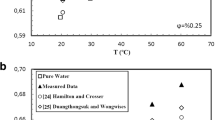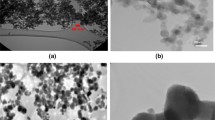Abstract
In this study, the characteristics of mixed convection heat transfer of nanofluids in circular microchannels with 500 μm diameter were investigated experimentally. In the study, water and water-based SiO2 nanofluids were used as the working fluid, and volumetric particle ratios of the nanofluids were selected as 0.2 and 0.4%. The thermal conductivity and viscosity characterizations of all fluids were performed in the temperature range of 20–60 °C, and the characteristics related to the temperature obtained from the measurements were used in calculations. The effect of the microchannel inclination angle and particle volumetric ratio on the mixed convection heat transfer characteristics was investigated. Upon examining the results, it was revealed that the range of 13–35% of the total heat transfer was generated by the natural convection effects. Increasing the inclination angle of the test section provided an enhancement between 4 and 13% in the total heat transfer. Furthermore, the increase in the volumetric particle ratio increased both forced convection heat transfer and the natural convection heat transfer components. Adding nanosized SiO2 particles into the water caused the total heat transfer to increase from 12 to 14% for 0.2 vol% and from 29 to 32% for 0.4 vol%.











Similar content being viewed by others
Abbreviations
- A :
-
Heat transfer surface area (m2)
- C p :
-
Specific heat at constant pressure (J kg−1 K−1)
- D :
-
Diameter (m)
- D T :
-
Thermophoretic diffusion coefficient (m2 s−1)
- D B :
-
Brownian diffusion coefficient (m2 s−1)
- Gr :
-
Grashof number
- Gz :
-
Graetz number
- g :
-
Gravitational acceleration (m s−2)
- h :
-
Convection heat transfer coefficient (W m−2 K−1)
- I :
-
Current (A)
- k :
-
Thermal conductivity (W m−1 K−1)
- k B :
-
Boltzmann constant (J K−1)
- L :
-
Length of tube (m)
- \(\dot{m}\) :
-
Mass flow rate (kg s−1)
- N T :
-
Thermophoresis parameter
- Nu :
-
Nusselt number
- Pr :
-
Prandtl number
- Ra :
-
Rayleigh number
- Re :
-
Reynolds number
- \(\dot{Q}\) :
-
Heat rate (W)
- T :
-
Temperature (°C)
- U :
-
Average velocity (m s−1)
- V :
-
Voltage (V)
- ρ :
-
Density (kg m−3)
- µ :
-
Dynamic viscosity (kg ms−1)
- β :
-
Thermal expansion coefficient (1 K−1)
- Φ :
-
Natural convection effect
- Ω :
-
A form of Nusselt number
- v :
-
Kinematic viscosity (m2 s−1)
- α :
-
Thermal diffusivity (m2 s−1)
- φ :
-
Nanoparticle volumetric fraction
- θ :
-
Microchannel inclination angle
- avg:
-
Average
- b:
-
Bulk
- bf:
-
Basefluid
- i:
-
İnlet
- nf:
-
Nanofluid
- np:
-
Nanoparticle
- o:
-
Outlet
- s:
-
Surface
- w:
-
Wall
References
Shen S, Xu JL, Zhou JJ, Chen Y. Flow and heat transfer in microchannels with rough wall surface. Energy Convers Manag. 2006;47:1311–25.
Agarwal A, Bandhauer TM, Garimella S. Measurement and modeling of condensation heat transfer in non-circular microchannels. Int J Refrig. 2010;33:1169–79.
Chiu H, Jang J, Yeh H, Wu M. The heat transfer characteristics of liquid cooling heat sink containing microchannels. Int J Heat Mass Transf. 2011;54:34–42.
Adham AM, Mohd-Ghazali N, Ahmad R. Thermal and hydrodynamic analysis of microchannel heat sinks: a review. Renew Sustain Energy Rev. 2013;21:614–22.
Choi SUS. Enhancing thermal conductivity of fluids with nanoparticles. In: Proceedings of the 1995 ASME international mechanical engineering congress and exposition, USA ASME FED. 1995;231:99–105.
Murshed SMS, Leong KC, Yang C. Enhanced thermal conductivity of TiO2-water based nanofluids. Int J Therm Sci. 2005;44:367–73.
Shawn AP, David GC, Paul VB. Thermal conductivity of nanoparticle suspensions. J Appl Phys. 2006;99:1–6.
Tavman I, Turgut A, Chirtoc M, Hadjov K, Fudym O, Tavman S. Experimental study on thermal conductivity and viscosity of water-based nanofluids. Heat Transf Res. 2010;41:339–51.
Angayarkanni SA, Philip J. Review on thermal properties of nanofluids: recent developments. Adv Colloid Interface Sci. 2015;225:146–76.
Wang XQ, Mujumdar AS. Heat transfer characteristics of nanofluids: a review. Int J Therm Sci. 2007;46:1–19.
Kakac S, Pramuanjaroenkij A. Review of convective heat transfer enhancement with nanofluids. Int J Heat Mass Transf. 2009;52:3187–96.
Wen D, Lin G, Vafaei S, Zhang K. Review of nanofluids for heat transfer applications. Partıcuology. 2009;7:141–50.
Li J, Kleinstreuer C. Thermal performance of nanofluid flow in microchannels. Int J Heat Fluid Flow. 2008;29:1221–32.
Sohel M, Saidur R, Sabri MFM, Kamalisarvestani M, Elias M, Ijam A. Investigating the heat transfer performance and thermophysical properties of nanofluids in a circular microchannel. Int Commun Heat Mass Transf. 2013;42:75–81.
Mohammed HA, Bhaskaran G, Shuaib NH. Heat transfer and fluid flow characteristics in microchannels heat exchanger using nanofluids: a review. Renew Sustain Energy Rev. 2011;15:1502–12.
Salman BH, Mohammed HA, Munisamy KM, Kherbett AS. Characteristics of heat transfer and fluid flow in microtube and microchannels using conventional fluids and nanofluids: a review. Renew Sustain Energy Rev. 2013;28:848–80.
Malvandi A, Ganji DD. Mixed convective heat transfer of water/alumina nanofluid inside a vertical microchannels. Powder Technol. 2014;263:37–44.
Hedayati F, Domairry G. Effects of nanoparticle migration and asymmetric heating on mixed convection of TiO2–H2O nanofluid inside a vertical microchannels. Powder Technol. 2015;272:250–9.
Derakhshan MM, Akhavan-Behabadi MA, Mohseni SG. Experiments on mixed convection heat transfer and performance evaluation of MWCNT–Oil nanofluid flow in horizontal and vertical microfin tubes. Exp Therm Fluid Sci. 2015;61:241–8.
Avramenko AA, Tyrinov AI, Shevchuk IV, Dmitrenko NP, Kravchuk AV, Shevchuk VI. Mixed convection in a vertical circular microchannels. Int J Therm Sci. 2017;121:1–12.
Kao MJ, Hsu FC, Peng DX. Synthesis and characterization of SiO2 nanoparticles and their efficacy in chemical mechanical polishing steel substrate. Adv Mater Sci Eng. 2014;1:1–8.
Hammerschmidt U, Meier V. New transient hot-bridge sensor to measure thermal conductivity thermal diffusivity and volumetric specific heat. Int J Thermophys. 2006;27(3):840–65.
Hamilton RL, Crosser OK. Thermal conductivity of heterogeneous two component systems. Ind Eng Chem Fundam. 1962;1:187–91.
Duangthongsuk W, Wongwises S. Measurement of temperature-dependent therma conductivity and viscosity of TiO2 water nanofluids. Exp Therm Fluid Sci. 2009;33:706–14.
Sharma KV, Sarma PK, Azmi WH, Mamat R, Kadirgama K. Correlations to predict friction and forced convection heat transfer coefficients of water based nanofluids for turbulent flow in a tube. Int J Microscale Nanoscale Therm Fluid Transp Phenom. 2012;3:1–25.
Azmi WH, Sharma KV, Mamat R, Najafi G, Mohamad MS. The enhancement of effective thermal conductivity and effective dynamic viscosity of nanofluids—a review. Renew Sustain Energy Rev. 2016;53:1046–58.
Mahian O, Kianifar A, Heris SZ, Wongwises S. Natural convection of silica nanofluids in square and triangular enclosures: theoretical and experimental study. Int J Heat Mass Transf. 2016;99:792–804.
Jung JY, Yoo YJ. Thermal conductivity enhancement of nanofluids in conjunction with electrical double layer (EDL). Int J Heat Mass Transf. 2009;52:525–8.
Ohshima H, Furusawa K. Electrical Phenomena at Interfaces: fundamentals. Measurements and applications. New York: Marcel Dekker Inc.; 1998.
Buongiorno J. Convective transport in nanofluids. J Heat Transf. 2005;128(3):240–50.
Buongiorno J. A Non-homogeneous equilibrium model for convective transport in flowing nanofluids. In: 2005 ASMEE summer heat transfer conference. Proceedings of HT2005.
Lister DH. Corrosion products in power generating systems. 1980; AECL-6877.
Müller-Steinhagen H. Cooling-water fouling in heat exchangers. Adv Heat Transf. 1999;33:415–96.
Nield DA, Kuznetsov AV. The Cheng-Minkowycz problem for the double-diffusive natural convective boundary layer flow in a porous medium saturated by a nanofluid. Int J Heat Mass Transf. 2011;54:374–8.
Li W, Feng ZZ. Laminar mixed convection of large-Prandtl-number in-tube nanofluid flow, part II: correlations. Int J Heat Mass Transf. 2013;65:919–27.
Feng ZZ, Li W. Laminar mixed convection of large-Prandtl-number in-tube nanofluid flow, part I: experimental study. Int J Heat Mass Transf. 2013;65:919–27.
Kline SJ, McClintock FA. Describing uncertainties in single-sample experiments. Mech Eng. 1953;75(1):3–8.
Durgaprasad P, Varma SVK, Hoque MM, Raju CSK. Combined effects of Brownian motion and thermophoresis parameters on three-dimensional (3D) Casson nanofluid flow across the porous layers slendering sheet in a suspension of graphene nanoparticles. Neural Comput Appl. 2018. https://doi.org/10.1007/s00521-018-3451-z.
Anbuchezhian N, Srinivasan K, Chandrasekaran K, Kandasamy R. Thermophoresis and Brownian motion effects on boundary layer flow of nanofluid in presence of thermal stratification due to solar energy. Appl Math Mech. 2012;33(6):765–79.
Evans W, Fish J, Keblinski P. Role of Brownian motion hydrodynamics on nanofluid thermal conductivity. Appl Phys Lett. 2006;88:1–3.
Shannon RL, Depew CA. Forced laminar flow convection in a horizontal tube with variable viscosity and free-convection effects. J Heat Transf. 1969;91:251–8.
Acknowledgements
This work was supported by Erzurum Technical University, Research Project Foundation (Project No. BAP-2015/3). The Authors wish to thank Erzurum Technical University.
Author information
Authors and Affiliations
Corresponding author
Rights and permissions
About this article
Cite this article
Manay, E., Mandev, E. Experimental investigation of mixed convection heat transfer of nanofluids in a circular microchannel with different inclination angles. J Therm Anal Calorim 135, 887–900 (2019). https://doi.org/10.1007/s10973-018-7463-9
Received:
Accepted:
Published:
Issue Date:
DOI: https://doi.org/10.1007/s10973-018-7463-9




